Best known for his world-renowned neuro-ophthalmology unit based at the University of California, San Francisco, William Hoyt, MD collected here more than 850 of his best images covering a wide range of disorders.
William F. Hoyt, MD, Professor Emeritus of Ophthalmology, Neurology and Neurosurgery, Department of Ophthalmology, University of California, San Francisco.
NOVEL: https://novel.utah.edu/
TO
| Title | Description | Type | ||
|---|---|---|---|---|
| 126 |
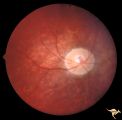 |
Cerebellar Macular Degeneration | Cerebellar retinal degenerative disease in a 12 year old boy who was blind and demented. His siblings were also blind. Was referred to as Voght-Spielmeyer Disease (Pair with R2_B1_3b shows granular retinal degeneration.) Anatomy: Retina. Pathology: Optic atrophy. Disease/Diagnosis: Congenital retina... | Image |
| 127 |
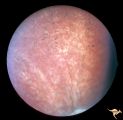 |
Cerebellar Macular Degeneration | Cerebellar retinal degenerative disease in a 12 year old boy who was blind and demented. His siblings were also blind. Was referred to as Vogt-Spielmeyer Disease. Pair with R2_B1_3a. Anatomy: Retina. Pathology: Optic atrophy. Disease/Diagnosis: Congenital retinal cerebral degeneration. Clinical: Sev... | Image |
| 128 |
 |
Cerebellar Macular Degenerative Disease | Ocular fundus shows prominent retinal degeneration in the region of the maculae, bilateral optic disc pallor with narrowed retinal arterioles. Interesting peripapillary halo of retinal pigment degeneration. Most consistent with Spinal Cerebellar Degeneration Type 7 (SCA-7). Anatomy: Retina. Patholog... | Image |
| 129 |
 |
Cerebellar Macular Degenerative Disease | Ocular fundus shows prominent retinal degeneration in the region of the maculae, bilateral optic disc pallor with narrowed retinal arterioles. Interesting peripapillary halo of retinal pigment degeneration. Most consistent with Spinal Cerebellar Degeneration Type 7 (SCA-7). Anatomy: Retina. Patholog... | Image |
| 130 |
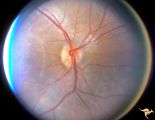 |
Cerebellar Macular Degenerative Disease | Cerebellar degeneration with granular maculae changes and bone spicules. Right eye. Anatomy: Retina. Pathology: Cerebellar macular degenerative disease. Disease/Diagnosis: Spinal Cerebellar Degeneration Type 7 (SCA-7). Clinical notes: Blindness and cerebellar degeneration. | Image |
| 131 |
 |
Cerebellar Macular Degenerative Disease | Cerebellar degeneration with granular maculae changes and bone spicules. Right eye. Anatomy: Retina. Pathology: Cerebellar macular degenerative disease. Disease/Diagnosis: Spinal Cerebellar Degeneration Type 7 (SCA-7). Clinical notes: Blindness and cerebellar degeneration. | Image |
| 132 |
 |
Cerebellar Macular Degenerative Disease | Cerebellar degeneration with granular maculae changes and bone spicules. Left eye. Anatomy: Retina. Pathology: Cerebellar macular degenerative disease. Disease/Diagnosis: Spinal Cerebellar Degeneration Type 7 (SCA-7). Clinical notes: Blindness and cerebellar degeneration. | Image |
| 133 |
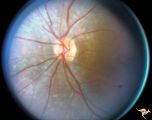 |
Cerebellar Macular Degenerative Disease | Cerebellar degeneration with granular maculae changes and bone spicules. Left eye. Anatomy: Retina. Pathology: Cerebellar macular degenerative disease. Disease/Diagnosis: Spinal Cerebellar Degeneration Type 7 (SCA-7). Clinical: Blindness and cerebellar degeneration. | Image |
| 134 |
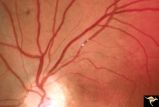 |
Cerebroretinal Microangiopathy (Susac Syndrome) | Two plaques which have been called Psuedo-emboli. This plaque is not the result of embolism, but is the result of the microangioplastic process underlying the syndrome. (NANOS 2001 by Egan, RA). Anatomy: Retina. Pathology: Microangiopathy involving brain, auditory nerve and retina. Disease/Diagnosi... | Image |
| 135 |
 |
Cerebroretinal Microangiopathy (Susac Syndrome) | Retinal signs of Susac's Syndrome in acute phase consist of areas of retinal artery infarction from branch retinal artery occlusions. This fundus shows two area of retinal infarction from occlusion of both superior and inferior branch retinal arterioles. Anatomy: Retina. Pathology: Microangiopathy... | Image |
| 136 |
 |
Cerebroretinal Microangiopathy (Susac Syndrome) | Retinal signs of Susac's Syndrome in acute phase consist of areas of retinal artery infarction from branch retinal artery occlusions. These patients are usually women, many of whom are demented and have hearing loss. Refs: 1) Susac, Hardiman, Sellhorst. Neurology. 1979. 29:313-316 2) Susac ""Susa... | Image |
| 137 |
 |
Cerebroretinal Microangiopathy (Susac Syndrome) | This fundus picture from a patient with Susac Syndrome shows a focal shiny plaque in the inferior retinal arteriole. This plaque is not the result of embolism, but is the result of the microangioplastic process underlying the syndrome. (NANOS 2001 by Egan, RA). Anatomy: Retina. Pathology: Microangi... | Image |
| 138 |
 |
Cerebroretinal Microangiopathy (Susac Syndrome) | Retinal signs of Susac's Syndrome in acute phase consist of areas of retinal artery infarction from branch retinal artery occlusions. Shows clearing retinal branch artery occlusion. Pathology: Retina. Pathology: Microangiopathy involving brain, auditory nerve and retina. Disease/Diagnosis: Cerebro... | Image |
| 139 |
 |
Cerebroretinal Microangiopathy (Susac Syndrome) | Retinal signs of Susac's Syndrome in acute phase consist of areas of retinal artery infarction from branch retinal artery occlusions. Branch artery occlusion beginning to clear. Note the occluded arteriole lying on top of the infarcted zone. Anatomy: Retina. Pathology: Microangiopathy involving br... | Image |
| 140 |
 |
Cerebroretinal Microangiopathy (Susac Syndrome) | There is a plaque superior to the disc at 12:00. This plaque is not the result of embolism, but is the result of the microangioplastic process underlying the syndrome. There is a ghost vessel inferiorly at 5:00 off the disc. (NANOS 2001 by Egan, RA). Anatomy: Retina. Pathology: Microangiopathy invo... | Image |
| 141 |
 |
Cerebroretinal Microangiopathy (Susac Syndrome) | There is an occlusion of the superior nasal retinal arteriole visible as a white ghost vessel at 11:00. Note: Collateral filling of the distal branches in two places. (NANOS 2001 by Egan, RA). Anatomy: Retina. Pathology: Microangiopathy involving brain, auditory nerve and retina. Disease/Diagnosis:... | Image |
| 142 |
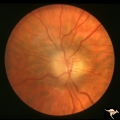 |
Chronic Atrophic Papilledema | Left eye. Left eye blind. Chronic Atrophic Papilledema. Obese woman (300 lbs) with large tentorial meningioma. "Pseudo Pseudotumor". Anatomy: Optic disc. Pathology: Papilledema. Disease/Diagnosis: Papilledema from large tentorial meningioma. | Image |
| 143 |
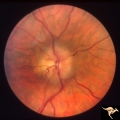 |
Chronic Atrophic Papilledema | Right eye. Chronic Atrophic Papilledema. Obese woman (300 lbs) with large tentorial meningioma. "Pseudo Pseudotumor" Anatomy: Optic disc. Pathology: Papilledema. Disease/Diagnosis: Papilledema from large tentorial meningioma. | Image |
| 144 |
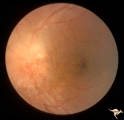 |
Chronic Papilledema in Resolution. Sequence | Left eye 2 weeks after presentation. Chronic papilledema in resolution. Note first evidence of a vertical choroidal fold. Anatomy: Optic disc. Pathology: Papilledema. Disease/Diagnosis: Papilledema. | Image |
| 145 |
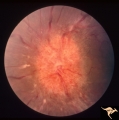 |
Chronic Papilledema in Resolution. Sequence | Left eye at presentation. Chronic papilledema. Anatomy: Optic disc Pathology: Papilledema Disease/Diagnosis: Papilledema | Image |
| 146 |
 |
Chronic Papilledema with Hemorrhagic and Exudative Complications | Left eye one month after presentation. Resolving hemorrhage. Chronic papilledema with hemorrhagic and exudative complications due to Pseudotumor cerebri. Anatomy: Optic disc. Pathology: Papilledema. Disease/Diagnosis: Chronic papilledema with hemorrhagic and exudative complications | Image |
| 147 |
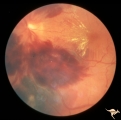 |
Chronic Papilledema with Hemorrhagic and Exudative Complications | Left eye at presesntation. Chronic papilledema with hemorrhagic and exudative complications due to Pseudotumor cerebri. Anatomy: Optic disc Pathology: Papilledema Disease/Diagnosis: Chronic papilledema with hemorrhagic and exudative complications. | Image |
| 148 |
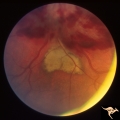 |
Chronic Papilledema with Hemorrhagic and Exudative Complications | Left eye one month after presentation. View below of resolving subretinal hemorrhage. Chronic papilledema with hemorrhagic and exudative complications due to Pseudotumor cerebri. | Image |
| 149 |
 |
Chronic Papilledema with Hemorrhagic and Exudative Complications | Left eye one month after presentation. View above of resolving preretinal hemorrhage. Chronic papilledema with hemorrhagic and exudative complications due to Pseudotumor cerebri. | Image |
| 150 |
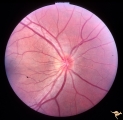 |
Congenitally Crowded Disc - Little Red Disc | Right eye: "little red disc". Congenitally blurred disc. 26 year old man. Anatomy: Optic disc Pathology: Normal variation of the optic disc Disease/Diagnosis: Normal variation of the optic disc. Congenital blurred disc. Little red disc. | Image |
